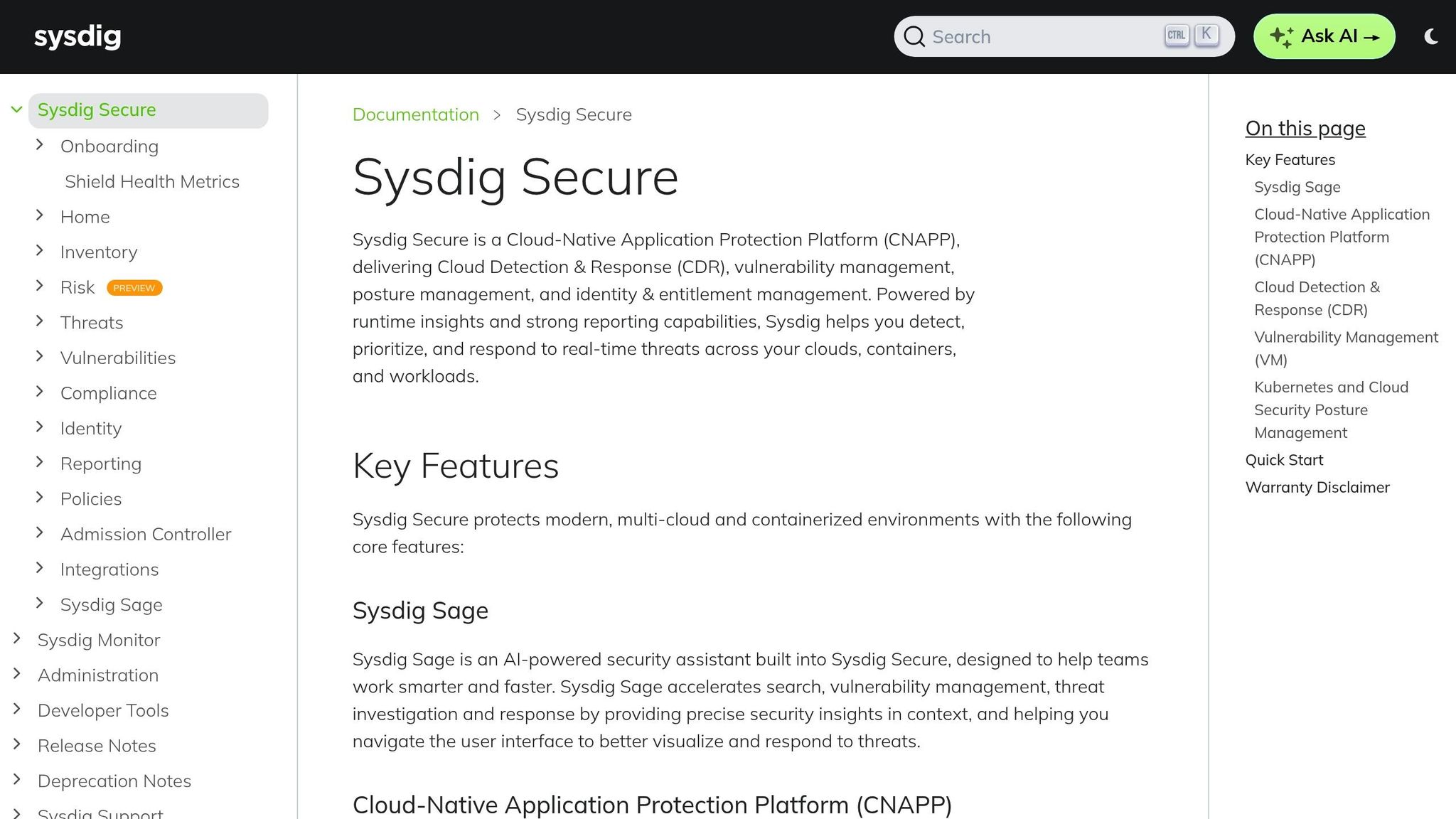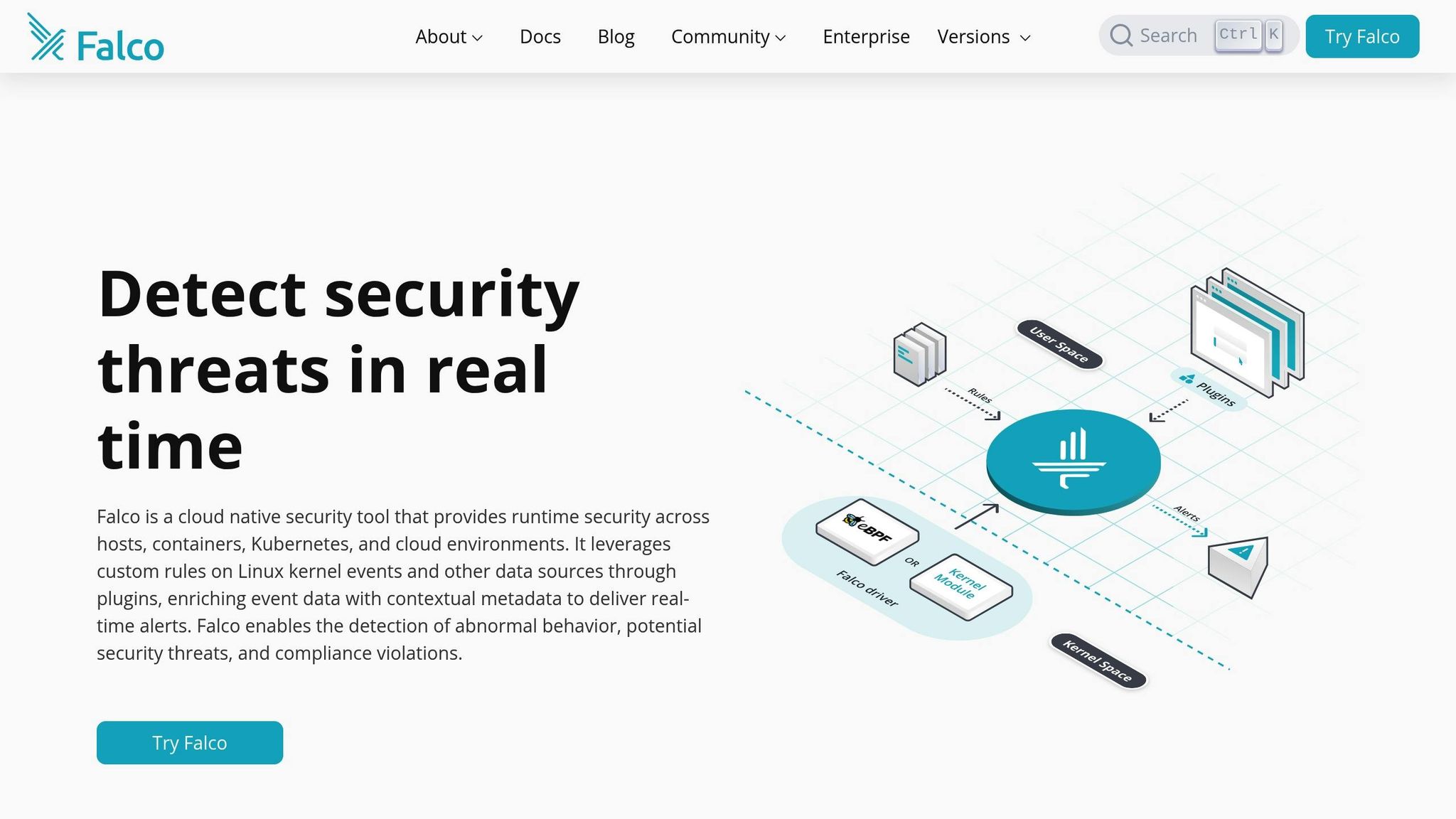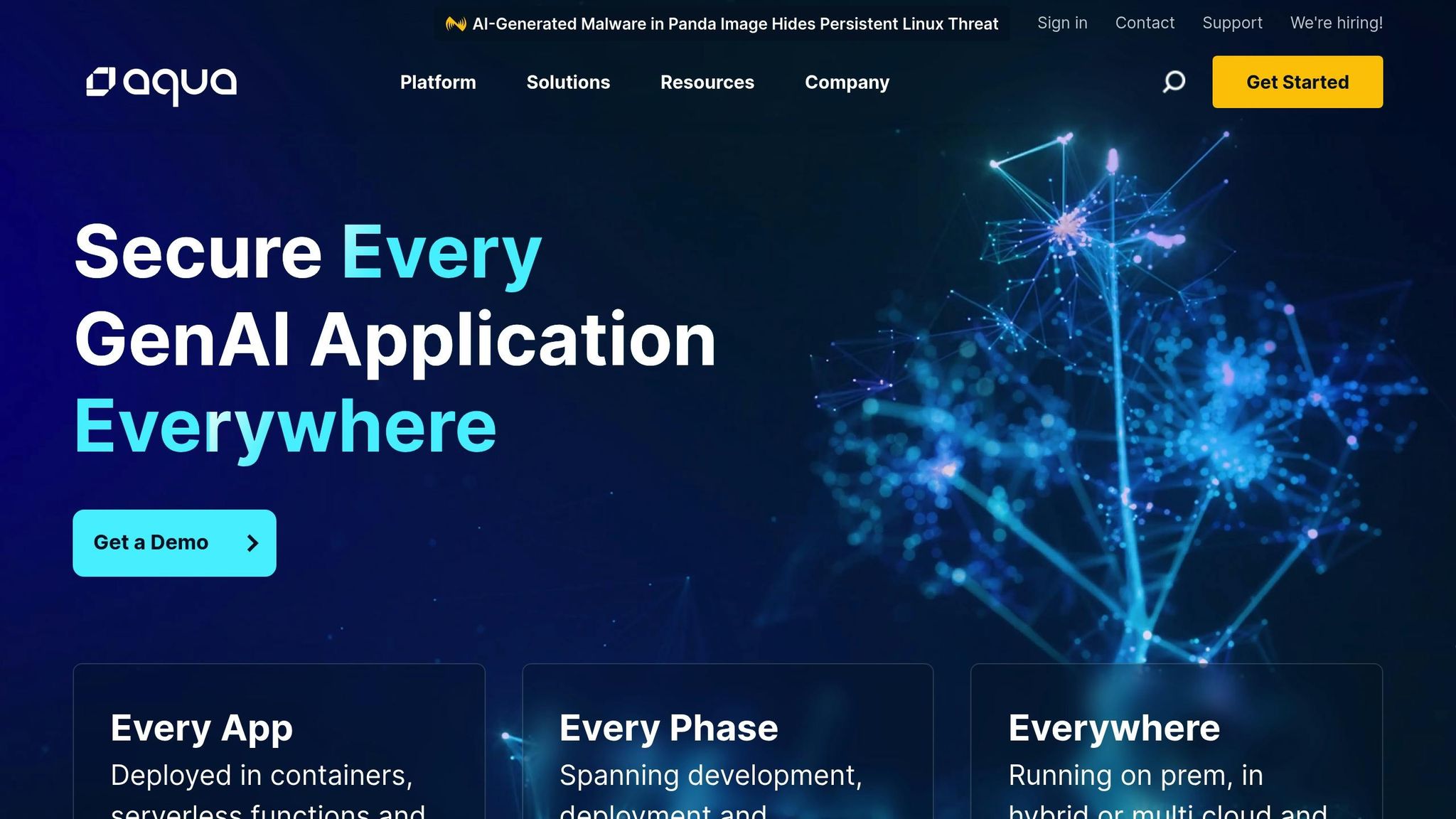AWS Fargate simplifies container management but introduces unique security challenges, particularly around detecting runtime threats. These threats, such as malicious code injection, cryptomining, and data leaks, occur when containers are actively running. Traditional security tools often fall short due to Fargate's serverless model, which restricts access to underlying infrastructure and logs.
Here’s how you can secure Fargate workloads:
- AWS GuardDuty ECS Runtime Monitoring: Uses sidecar containers for visibility into runtime activities like file access, processes, and network connections. It integrates with AWS services and minimizes performance impact by offloading analysis to AWS's backend.
- Third-Party Tools: Options like Sysdig Secure, Falco, and Aqua Security's MicroEnforcer offer runtime protection by deploying lightweight agents or sidecars alongside application containers.
To implement runtime threat detection:
- Use sidecar-based monitoring tools compatible with Fargate’s architecture.
- Centralize logs with CloudWatch or similar tools to retain forensic data.
- Regularly update detection rules to reduce false positives and improve accuracy.
Key Takeaway: Real-time threat detection is critical for compliance and rapid incident response in Fargate environments. AWS-native tools and third-party solutions provide effective ways to monitor ephemeral workloads while maintaining security and performance.
Requirements for Runtime Threat Detection in Fargate
Setting up runtime threat detection in Fargate means adapting to its unique serverless design. Let’s break down how Fargate’s architecture shapes the way security measures are implemented.
How Fargate's Model Affects Security
Fargate eliminates direct access to the underlying EC2 instances and nodes it operates on. Because of this, traditional host-level security agents simply can’t be installed. This design calls for a different approach to container monitoring, one that aligns with Fargate’s serverless and containerized structure. Security strategies need to be reimagined to fit these constraints effectively.
AWS-Native Solutions for Runtime Threat Detection
AWS offers built-in security tools that seamlessly integrate with Fargate workloads, eliminating the need for additional infrastructure management. These tools tap into AWS's service ecosystem to provide robust threat detection capabilities.
Amazon GuardDuty ECS Runtime Monitoring
Amazon GuardDuty ECS Runtime Monitoring tackles Fargate's security challenges by deploying a managed security agent as a sidecar container within each Fargate task. This setup is tailored to Fargate's architecture, delivering runtime visibility at the container level.
The agent keeps an eye on OS-level activities like file access, process execution, and network connections. It processes billions of events per minute from AWS data sources, combining runtime insights with control plane and network data from VPC Flow Logs, DNS logs, and CloudTrail. This approach helps detect complex, multi-stage attacks.
"GuardDuty combines machine learning (ML), anomaly detection, network monitoring, and malicious file discovery against various AWS data sources. When threats are detected, GuardDuty generates security findings and automatically sends them to AWS Security Hub, Amazon EventBridge, and Amazon Detective." – AWS News Blog
When a threat is identified, GuardDuty generates detailed findings that include rich contextual data, such as the ECS cluster ID, task ID, container name, associated tags, and runtime details like process ID, executable path, SHA-256 hash, and process lineage. It supports over 30 runtime-specific finding types, contributing to a total of 164 finding types - five times more than when it launched in 2017.
For Fargate deployments, GuardDuty automatically sets up a VPC endpoint and security group to securely transfer runtime events from the agent to the GuardDuty service API. By offloading resource-intensive tasks like rule matching and analysis to its backend, GuardDuty minimizes the performance impact on your workloads.
To implement this feature, ensure your Fargate tasks' IAM TaskExecutionRole has permissions to pull the GuardDuty sidecar container image from Amazon ECR. Restart any active tasks after enabling the feature to deploy the sidecar container. AWS offers a 30-day free trial, with pricing based on vCPU usage per hour after the trial ends.
AWS-Native Feature Comparison
GuardDuty ECS Runtime Monitoring offers distinct benefits compared to traditional monitoring tools. One of its key strengths is its container-specific context. While traditional GuardDuty log sources provided only instance-level data, this feature delivers container-level details - like task ID and container name - making it easier for security teams to identify affected containers during an incident.
Its managed design eliminates the operational burden of deploying and maintaining security agents. GuardDuty handles tasks like installation, configuration, updates, and management. Leveraging eBPF technology, the agent sends telemetry to AWS's backend for analysis, avoiding resource-heavy rule matching within your Fargate tasks.
GuardDuty's integration capabilities further boost its effectiveness. Findings automatically flow to AWS Security Hub, Amazon EventBridge, and Amazon Detective, enabling automated responses and centralized security management. Over 90% of the top 2,000 AWS customers rely on GuardDuty, which protects millions of accounts and more than half a billion EC2 instances.
However, there are some limitations to consider. Existing tasks must be restarted to enable full monitoring coverage, IAM permissions must be configured correctly, and task sizing should account for the GuardDuty agent's resource usage.
Third-Party Tools for Runtime Threat Detection
In addition to AWS-native tools, third-party solutions provide an extra layer of runtime threat detection for Fargate deployments. These tools address Fargate's access restrictions by using sidecar or standalone agents. Here's a closer look at how these tools work and what they bring to the table.
Sysdig Secure

Sysdig Secure takes advantage of Fargate's SYS_PTRACE capability to trace kernel system calls and monitor runtime events. It uses a two-part deployment model: a standalone orchestrator agent and sidecar monitoring agents that run within application tasks. This setup captures system calls and runtime data for identifying threats. To make deployment easier, Sysdig offers CloudFormation templates and Terraform modules.
Falco

Falco is an open-source security tool designed for runtime monitoring. It operates as a sidecar container alongside application containers, keeping an eye out for suspicious activity in containerized environments. Its flexibility and community-driven development make it a popular choice for many teams.
Aqua Security's MicroEnforcer

Aqua Security's MicroEnforcer provides lightweight runtime protection by deploying a small agent alongside application containers. This agent continuously monitors system calls and container activities, integrating smoothly with Fargate to deliver immediate threat detection without adding significant overhead.
Third-Party Tool Comparison
Below is a quick comparison of these tools' deployment models and key features:
| Tool | Deployment Model | Key Feature |
|---|---|---|
| Sysdig Secure | Standalone orchestrator with sidecar agents | Real-time threat detection using SYS_PTRACE |
| Falco | Sidecar container | Open-source monitoring leveraging SYS_PTRACE |
| Aqua Security's MicroEnforcer | Sidecar container with minimal agent | Lightweight, continuous runtime protection |
Each of these tools offers a unique method for runtime threat detection, allowing teams to choose the solution that aligns best with their operational needs and expertise.
sbb-itb-6210c22
Best Practices for Runtime Threat Detection Implementation
Once you've set up native and third-party monitoring agents, follow these best practices to keep your Fargate environment secure and running smoothly. These steps build on earlier discussions about Fargate threat detection, helping you streamline deployment and maintain operational efficiency.
Deploying and Configuring Detection Tools
Before deploying your detection tools, make sure to attach the necessary IAM policies, such as AmazonGuardDutyAgentAccess. If you're using sidecar-based tools, include the SYS_PTRACE capability in your task definitions.
For consistent deployments, use Terraform or CloudFormation. Many third-party vendors offer pre-built templates that include everything you need, like IAM roles, task definitions, and networking configurations.
Testing in a staging environment is critical. Runtime monitoring tools can affect application performance, particularly during the initial learning phase. Use a staging setup that mirrors your production environment to evaluate performance impact before rolling out the solution to your critical systems.
Once deployed, configure CloudWatch logs and metrics for your detection agents. This ensures you can troubleshoot issues and verify the tools are working as intended. After deployment, fine-tune detection rules to maintain effective and relevant alerting.
Managing Detection Rules and Alerts
Start with the default rules provided by your detection tools, then refine them over time based on your environment and alert volume. These out-of-the-box rules typically cover common threats, but monitoring their effectiveness for the first few weeks will help you identify areas for improvement.
Set severity levels for alerts to prioritize responses:
- High-severity alerts: Focus on critical threats like privilege escalation attempts or unusual network activity. These should trigger immediate notifications to your security team.
- Medium-severity alerts: Cover potentially malicious behavior that requires investigation but isn't urgent. These could generate tickets in your incident management system.
- Low-severity alerts: Log informational events that may be useful for forensic analysis but don't need immediate attention.
To reduce false positives, create environment-specific rule sets. Development environments often produce more experimental activity, which can trigger unnecessary alerts. Adjust sensitivity levels and rules based on the environment.
Define clear escalation procedures for each alert level. For example, high-severity alerts might page your security team immediately, while medium-severity ones could trigger a less urgent workflow. Document these procedures and ensure everyone involved knows their role.
Regularly review and adjust your detection rules. Analyze alert patterns monthly to identify false positives and refine noisy rules. Document any custom rules you create, along with the reasoning behind them, for future reference.
Finally, integrate your detection tools with existing security systems like your SIEM or orchestration platforms. Centralizing alerts allows you to correlate runtime threats with other security events across your infrastructure.
Monitoring Coverage and Performance Impact
Once your detection rules are in place, focus on ensuring full monitoring coverage while minimizing performance overhead.
Start by creating an inventory of all your Fargate services. Use tools like AWS Config rules or custom scripts to identify Fargate tasks that lack proper monitoring. Make sure runtime monitoring is enabled for all critical services, but consider applying selective monitoring for non-critical workloads to manage costs and performance.
Establish performance baselines before deploying monitoring tools. Measure metrics such as application response times, throughput, and resource usage. After deploying the tools, compare these metrics to assess the performance impact. Use CloudWatch to track agent resource usage and set up alerts if usage exceeds acceptable thresholds.
As your Fargate usage grows, plan for scaling. Monitoring costs often increase with the number of containers being tracked. Incorporate these costs into your capacity planning and consider automating policies to enable monitoring only for production workloads or during business hours in development environments.
Finally, monitor the health of your monitoring tools. Set up CloudWatch dashboards to track metrics like agent uptime, alert processing latency, and data ingestion rates. Keeping an eye on these metrics ensures your detection infrastructure remains reliable and effective.
Conclusion
Fargate’s design, which abstracts much of the infrastructure, makes agent-based monitoring essential for keeping track of container activities like file access, process execution, and network connections.
To achieve this, you can opt for AWS-native solutions such as Amazon GuardDuty ECS Runtime Monitoring or leverage third-party tools like Sysdig Secure or Falco. These tools deploy sidecar agents to provide the visibility needed for monitoring container behaviors effectively.
Real-time detection is especially important for ephemeral workloads. Short-lived containers are susceptible to automated attacks, and agentless approaches often fall short, as they lack the forensic data and live visibility necessary for a proper incident response.
For centralized monitoring and automated responses, integrate runtime detection with tools like AWS Security Hub, EventBridge, or external SIEM platforms. This approach not only enhances security but also helps meet compliance standards such as PCI and FedRAMP.
FAQs
How does AWS GuardDuty enhance security for Fargate workloads through ECS Runtime Monitoring?
AWS GuardDuty strengthens the security of your Fargate workloads by leveraging ECS Runtime Monitoring to spot and address potential threats during runtime. It simplifies the process by automatically managing the security agent on your container instances. By analyzing runtime activities - like network traffic and logs - it can flag unauthorized actions or unusual behavior.
This integration pairs effortlessly with other AWS services, such as AWS CloudWatch for real-time alerts and AWS Security Hub for centralized threat management. Together, these tools provide a cohesive framework for identifying and responding to security issues quickly and effectively, ensuring your Fargate workloads remain protected against ever-changing threats.
What’s the difference between AWS-native and third-party tools for detecting runtime threats in Fargate, and how do I choose the right one?
AWS-native tools, such as Amazon GuardDuty and ECS Runtime Monitoring, are designed to work directly within the AWS ecosystem. They integrate effortlessly with AWS services, offering real-time threat detection while utilizing features like IAM and Config. These tools are ideal for teams that want a straightforward, cost-effective solution that works right out of the box.
In contrast, third-party tools like Sysdig Secure come with added capabilities, including more detailed visibility, enhanced threat detection, and compatibility with multi-cloud or hybrid environments. These are a better fit for organizations with more complex infrastructures or those requiring tailored solutions.
When choosing between the two, think about your specific security needs, the structure of your current setup, and whether you prefer the simplicity of native tools or the adaptability of third-party options.
How can I manage and optimize detection rules in AWS Fargate to reduce false positives and ensure strong threat detection?
To keep detection rules in AWS Fargate running smoothly and effectively, it's essential to regularly review and adjust thresholds and filters. This helps cut down on false positives while still providing strong protection against potential threats. You can also manage exceptions by excluding activities you know are safe, and leverage AWS-native tools like GuardDuty for real-time monitoring.
Stay proactive by refining your detection logic with insights from threat intelligence and operational feedback. Automating rule updates and performing regular audits can further improve accuracy and reduce unnecessary alerts, helping to ensure your Fargate workloads stay secure and well-guarded.


